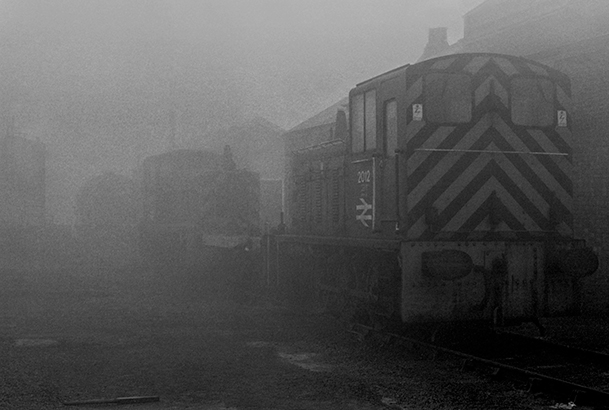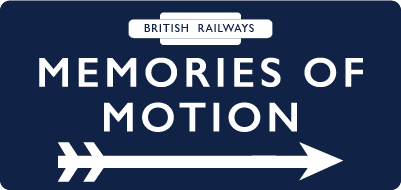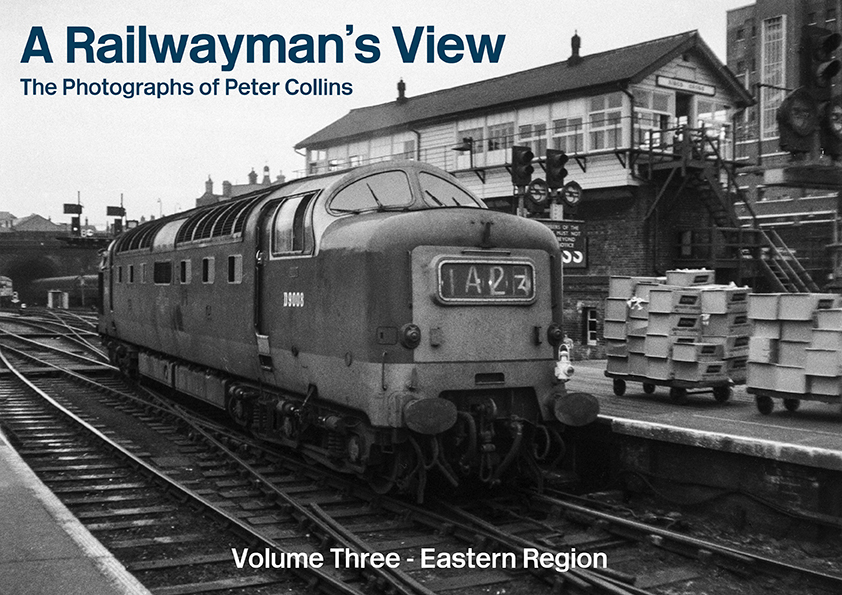What Was the Eastern Region of British Rail?
The Eastern Region of British Rail operated the East Coast Main Line (ECML) from Kings Cross to Yorkshire and Scotland, plus the Great Eastern lines from Liverpool Street across East Anglia, from nationalisation in 1948 until privatisation in 1994-1995. This 200+ page photographic volume documents these railways during the 1960s through early 1980s, captured by Peter Collins during his career working for British Railways.
One autumn afternoon in 1977, a running inspector walked into the freight operating office at Liverpool Street station with unexpected news: a Romanian-built Class 56 locomotive had just turned up at Stratford depot. Peter Collins volunteered immediately to photograph it.
This wasn’t unusual. Working for British Rail during the 1970s meant being surrounded by railway enthusiasts in the office—efficient, competent people who weren’t above sneaking out early to photograph Deltics in their final days at Kings Cross. Peter’s unique position as a BR employee gave him access that civilian photographers could only dream of: he could walk into Stratford Works, photograph inside March shed on foggy mornings, and capture the working railway from staff-only vantage points.
This unprecedented access forms the heart of “A Railwayman’s View: Volume 3 – Eastern Region” by Peter Collins, now available from Memories of Motion. The book documents British Rail’s Eastern Region during the 1960s, 1970s, and early 1980s through over 180 previously unpublished photographs.
Why Was the Eastern Region Important to British Rail?
The Eastern Region represented a fascinating cross-section of British Rail operations. The southern end of the East Coast Main Line (ECML) from Kings Cross to Yorkshire carried prestigious express services hauled by the legendary Deltic Class 55 locomotives. Liverpool Street station served the Great Eastern lines radiating across East Anglia, where Brush Type 2 Class 31s and English Electric Type 3 Class 37s were as indigenous as the B12s and J15s had been in the steam era.
Peter’s career path gave him perfect access to both territories. After joining BR at the Southern Region’s South Eastern Division, he moved to the Freight Operating office at Liverpool Street, dealing with everything from Temple Mills Yard workings to special freight movements on the ex-Midland and Great Northern line from Lenwade to Ripple Lane. Later, he was “head-hunted” by the Passenger Operating office just across the corridor, giving him opportunities for cab rides to Norwich on Class 47s and visits to Stratford Works to see the first Romanian Class 56 locomotives arriving for modifications.
What Made Kings Cross Station Special During the British Rail Era?
Lewis Cubitt’s Kings Cross station has been the southern terminus of the East Coast and Great Northern lines for just under 175 years. Peter captures it across three decades—from the early 1960s with steam still present, through the Deltic era of the 1970s, to the early days of electrification.

One photograph shows Peppercorn A1 60144 ‘KING’S COURIER’ waiting to depart north in the early 1960s, taken with the same Box Brownie camera Peter used at Paddington for Volume One. The soot and grime covering the train shed roof is striking—within a few years, most of the cladding would be gone, never to be replaced.
The 22 Deltic Class 55 locomotives replaced 55 Pacifics from the East Coast and Great Northern main lines, eliminating the need to change engines en route. Peter’s photographs capture these magnificent machines in their final years of serious Inter City work. One summer’s evening, he and office colleagues sneaked out early to Kings Cross to record the Deltics before they were displaced by High Speed Trains. The images show them in the station where Cubitt’s train shed formed a perfect amplifier for the mighty Napier engines—when several Deltics were departing to the north, your whole chest would resonate with the sound.
Historical Note
During the 1960s and 1970s, Kings Cross remained largely unchanged, reflecting its past as a steam station. However, after the opening of the new Moorgate tunnels and the electrification of the GN Suburban routes in the mid-1970s, the station began to lose its character, particularly from platform level. The advent of High Speed Trains and the introduction of Class 91 InterCity 225 trains led to the closure of the station fuelling-point and Finsbury Park shed to the north. (Source: Railway heritage documentation at the National Railway Museum, York)
Stratford: Inside the Works
The most valuable photographs in Volume 3 document Stratford Works and the adjacent 30A depot. Peter’s BR credentials gave him unrestricted access to capture scenes that external photographers could never reach.

The lifting shop photographs are particularly striking. One image shows English Electric Type 3 Class 37 number 6724 (later 37 024) on jacks, having been lifted off its bogies for major repair work. Another reveals the vast interior of the period buildings where, during the inter-war period, steam locomotives such as B12 4-6-0s and J15 0-6-0s had been worked on or even constructed. By the mid-1970s, it was almost as busy but quieter and cleaner. The photograph shows multiple locomotive types under maintenance: late English Electric Type 3 Class 37s, a 350hp Class 08 shunter, a Freightliner container set with a Brush Type 2 Class 31, and a Brush Type 4 Class 47—the latter responsible for Norwich Inter City services.
Weekend visits to Stratford 30A revealed the depot’s enormous allocation. One Saturday afternoon, Peter photographed over half of 30A’s allocation of first-batch Brush Type 2 Class 31s queued up in a single siding. These 1250hp locomotives were only ever allocated to 30A and were affectionately known as ‘Toffee Apples’ because the power controller on the cab desk was shaped like a ball on a stick. Eight Class 08 350hp shunters enjoying a Saturday morning rest—come Monday, they would be scuttling around yards from Temple Mills to Ripple Lane to Bow Creek and further afield.
The depot also housed railway history in storage. Peter photographed the last two extant Baby Deltic English Electric Type 2 Class 23s, dumped on their own adjacent to redundant shunters. Number 5909 was the only example painted blue. They had outlived their siblings purely to be retained for engineers’ train working. Both were cut up in 1973 by Cohen’s.
Liverpool Street: The Great Eastern Terminus
Liverpool Street station, designed by Edward Wilson, celebrates its 150th birthday in November 2025. Wilson would not recognise the station today, but he would possibly recognise that captured by Peter during the 1970s.
Peter’s photographs were taken from staff-only vantage points that reveal the station before high-rise glass-fronted offices covered the train shed roof. The Great Eastern pioneered the switch from steam to diesel in 1957-58 and continued to use locomotive-hauled services until very recently. Peter’s images show diesel locomotives on services to Cambridge, Kings Lynn, Ipswich, Harwich, and Norwich interspersed with the “mind-numbing hum” of electric motors departing platforms.
Working in the original GER office building with its main entrance in the City’s Bishopsgate, Peter and his colleagues could observe morning peak arrivals from the Shenfield lines between 08:00 and 09:00 from the vast sash windows—cold and draughty in winter, hot in summer. This gave them ammunition to take up any late running with train crews. The frequent visits of Movements Inspectors meant Peter could rush to Stratford Works at a moment’s notice or take cab rides to Norwich on Class 47s.
Yorkshire: Coal, Steel, and the ECML Spine
“God’s own country,” or home to Doncaster Works—Yorkshire probably had the largest variety of trains and locomotives anywhere in the UK. Driven by coal and steel, it had a vast network of freight with the ECML as its spine.
Peter’s photographs capture this diversity: double-headed MGR coal drags with Class 76 EM1 electrics passing over Penistone, steel trains headed by Sulzer Type 2 Class 25s at Huddersfield, and Peak Class 46s on Trans Pennine expresses. One evocative image shows a young trainspotter wrapped up in his Parker coat watching a Class 40 on a parcels service at Huddersfield on a bitterly cold, damp, and misty Saturday morning—the long line of Vanfits at the platform suggesting the approach of Christmas.
How Did Colin T. Gifford Influence Railway Photography?
The line to Norwich held Peter’s main photographic attention in East Anglia, except for visits to March shed, which saw a wide variety of locomotive types and varied freight traffic. These visits led to Peter using his Colin T. Gifford inspiration to full effect.
Colin T. Gifford (1913-1985) pioneered a “New Approach” to railway photography, particularly during the decline of steam, documented in his influential publications through Ian Allan Limited. Gifford’s work often relied on abstraction to capture the “dirty working atmosphere” of the railways. He would photograph misty industrial landscapes, sweating railway workers, rain-swept nocturnal platforms, and sulphurous engine sheds where trains might be an “afterthought” or entirely absent.
Peter’s translation of Gifford’s philosophy is evident throughout Volume 3. One sequence from March began in thick fog. Undeterred, Peter decided on a shed bash and toured the depot without anyone detaining him—though he had to be extremely careful as visibility was reduced and noises were muffled. He photographed three 204hp Class 03 shunters headed by number 2012 (later 03 012) laying over, complete with their attached shunters’ wagons. A brief clear moment allowed a shot of English Electric Type 3 Class 37 number 6759 (later 37 059) standing at the fuelling-point with a Brush Type 4 Class 47 dimly visible in the background.

These atmospheric images capture the working railway in a way that clinical sunshine photographs never could—the fog and mist revealing the industrial reality of British Rail operations.
What’s Inside Volume 3?
The book documents the Eastern Region through detailed chapters covering:
- London Kings Cross: Three decades of photographs from the 1960s to 1980s
- Finsbury Park: Home of the Deltics, captured working hard on the climb from Kings Cross
- GN Suburbs: Electrification in the mid-1970s and trains running over 100mph
- Lincolnshire: East coast seaside resorts and summer locomotive-hauled services
- Yorkshire: The vast network driven by coal and steel
- North East & Scotland: Select photographs from Peter’s eastern journeys
- London Liverpool Street: The Great Eastern terminus before modern redevelopment
- Bethnal Green & Barking: Junction points and views of London
- Stratford: The depot complex and works in its heyday
- East Anglia: Norwich line services and March shed atmospheric photography
Every photograph includes detailed captions with technical locomotive information, location and date details, historical context, and personal reminiscences from Peter’s British Rail career.
Perfect for Enthusiasts and Gift-Buyers
If you’re a railway enthusiast, Volume 3 offers unprecedented behind-the-scenes access to Eastern Region operations during the transitional era from the 1960s through the early 1980s. The Stratford Works photographs document maintenance practices that are now completely forgotten, whilst the March shed atmospheric images showcase Colin T. Gifford’s influential photographic philosophy.
If you’re buying a gift for someone who loves railways, this book covers Britain’s most significant railway territory. The Eastern Region included London, Yorkshire, Lincolnshire, and East Anglia—almost everyone in England has a connection to these railways. The timeframe from the 1960s through the early 1980s means your recipient likely has personal memories of Deltics, Class 37s, and the transformation from steam to modern traction.
Softback edition: 200+ pages
Now available at
FAQ
What locomotive classes are featured in this Eastern Region book?
The book extensively features Class 55 Deltics (the legendary East Coast express locomotives), Class 47 Brush Type 4s handling Norwich Inter City services, Class 31 Brush Type 2s (the Great Eastern workhorses), Class 37 English Electric Type 3s on freight and passenger duties, Class 76 EM1 electrics on the Woodhead route, and numerous other classes including Class 08 shunters, Class 25s, Class 40s, and Class 46 Peaks. Peter’s insider access captured these locomotives in working environments that external photographers could never reach, particularly at Stratford Works and March depot.
What time period does this Eastern Region volume cover?
Volume 3 documents the Eastern Region primarily through the 1960s, 1970s, and early 1980s—covering the final years of steam, the diesel era with Deltics and Class 47s, and the beginning of electrification programmes. Peter photographed specific dated events including the last days of Deltic operations before High Speed Train introduction (1978-1981), the Romanian Class 56 arrivals at Stratford in 1977, and the Woodhead Route Class 76 electrics before closure in 1981.
How did Peter Collins gain access to photograph inside BR facilities?
Peter worked for British Rail in operational roles from the late 1960s through the 1980s, first in the Freight Operating office at Liverpool Street, then in the Passenger Operating office. This gave him legitimate staff access to areas civilians could never enter: Stratford Works lifting shops, March TMD during foggy mornings, the GER office building overlooking Liverpool Street station, and even invited access to signal boxes like Huddersfield Junction. His British Rail credentials meant he could photograph working railway operations without security concerns.
Is this book suitable as a gift for someone interested in British Rail?
Absolutely. The Eastern Region covered Britain’s most significant railway territory—London (Kings Cross and Liverpool Street), Yorkshire, Lincolnshire, and East Anglia—so almost everyone in England has a personal or family connection to these railways. The 1960s-1980s timeframe means your recipient likely has direct memories of Deltics, diesel services, or the transition from steam. The book includes both technical detail for serious enthusiasts and accessible narrative for those less familiar with railway operations, making it suitable for gift-giving across expertise levels.
What makes the Stratford Works photographs particularly valuable?
The Stratford Works photographs are historically priceless because they document maintenance practices and behind-the-scenes operations that were never meant to be photographed. Peter’s staff access allowed him to capture locomotives lifted off their bogies in the lifting shop, depot allocation yards on quiet weekends, the last Baby Deltic Class 23s in storage before scrapping, and the vast period buildings that housed Great Eastern Railway construction and maintenance since the Victorian era. The entire site was obliterated for the 2012 London Olympics, so these images preserve a vanished world that can never be photographed again.

Next time: We explore the Deltic legend—why the Class 55 became the most celebrated diesel locomotive in British railway history.


Leave a Reply